⚡ TL;DR: How Do I Create a Content Marketing Strategy?
Start with a content marketing blueprint: a strategic system that connects your content to real business outcomes like qualified leads, conversions, and long-term growth. Without it, content remains disconnected and inconsistent. A solid blueprint brings together:
- Clear business goals tied to content output
- Audience personas and messaging based on real data
- Content types matched to funnel stages
- Workflows, publishing systems, and review cycles
- Metrics to track performance, impact, and ROI
This guide walks you through 9 must-answer questions to help you build a content strategy that actually works and keeps working.
Your Content Won’t Work Unless It Has a Plan
I used to publish a lot of content – blog posts, emails, updates, social. It looked consistent from the outside.
But behind the scenes, none of it was driving real results.
There were no conversions. No clarity on what was working. No system I could scale.
And soon enough, after a lot of research and soul searching, it hit me: I didn’t need more content. I needed a blueprint.
Because without a blueprint, content is just activity. It doesn’t matter how good your writing is, how often you post, or how polished it looks… if there’s no structure tying it back to business goals, it’s not marketing. It’s noise.
And I’m not the only one who’s learned this the hard way.
📉 57% of marketers still don’t have a documented strategy and only 19% say the one they do have is advanced.
That stat says it all. Ideas aren’t the issue. It’s the disconnect.
Disconnected from outcomes. From the buyer journey. From anything that actually moves the business forward.
That’s what this guide is here to fix.
I’m going to walk you through the 9 essential questions every content marketing blueprint must answer and how those answers shape the system behind consistent, conversion-focused content.
If you’re building from scratch or cleaning up a scattered strategy, this is the starting point. These are the questions I ask in every content audit, planning sprint, and client workshop because they work.
Let’s get into it.
The 9 Questions Your Content Marketing Blueprint Must Answer
If your blueprint doesn’t answer these, it’s not a strategy. All you’ve got is a list of blog ideas in a trench coat.
These 9 questions form the foundation of a content system that works and brings in more leads, more conversions, more control over growth.
Whether you're building from scratch or cleaning up a scattered strategy, these are the checkpoints that separate a content machine from content chaos.
A content marketing blueprint is your high-level strategic system, not just what you post, but why you post it, who it’s for, where it fits in the buyer journey, and how it contributes to business goals.
It gives your content direction, structure, and a measurable purpose. Without it, you're guessing. Creating content that looks good but doesn't convert. With it, every piece becomes a step in a larger, trackable system designed to drive action.
This isn’t just a strategy doc. See it as a buildable, operational system. Here's the high-level flow:
- Phase 1: Foundation – Set your business goals, clarify brand voice, define your audience, and audit what you’ve already got.
- Phase 2: Planning – Choose content types, build topic clusters, set your editorial calendar, and create briefs.
- Phase 3: Execution – Define workflows, assign roles (even if it's just you), and build feedback loops.
- Phase 4: Iteration – Set review cycles, analyze performance, and optimize with what you learn.
We’ll break this down further in Section II.
A real strategy isn’t just a calendar. It includes:
- A clear value proposition and voice
- Documented brand + audience personas
- Pillar topics and supporting content
- Defined funnel stages and buyer journeys
- A mapped workflow and content lifecycle
- Distribution + promotion strategy
- A performance dashboard with KPIs and feedback loops
Each part supports the next. If one’s missing, you’ll feel it in your results.
Start with data: surveys, interviews, search terms, analytics, support queries – anywhere people are already telling you what they want.
Then build personas grounded in real behavior, not wishful thinking. Ask:
- What are they trying to solve?
- What stage are they in?
- What content already works for them?
- What objections or barriers do they face?
This gives you messaging that lands, and content that moves people toward action.
Don’t post everywhere. Post where it counts.
Map content types to funnel stages:
- TOFU: Educational blog posts, SEO content, YouTube
- MOFU: Case studies, email sequences, webinars
- BOFU: Sales pages, product demos, retargeting ads
Then choose channels your audience already trusts and build a distribution loop that fits your team’s capacity.
You don’t need a huge team. You need a repeatable process.
Build a workflow with:
- Standardized briefs and templates
- A realistic production calendar
- A simple feedback + approval loop
- A promotion checklist
- One place where everything lives (Notion, Asana, Thrive Apprentice)
Even if it’s just you, defining the process gives you leverage and makes it easier to scale or outsource later.
Don’t reinvent the wheel. Build with tools that reduce friction.
Some essentials:
- Editorial calendar: Google Sheets or Notion
- Publishing + landing pages: Thrive Architect
- Project tracking: Asana or ClickUp
- AI support: Use tools like ChatGPT for idea generation, outlines, or content repurposing
Templates and frameworks help you stay consistent without burning out.
If you can’t measure it, you can’t improve it. Set Specific, Measurable, Achievable, Relevant, Time-bound goals tied to business metrics.
Examples:
- Increase email opt-ins from blog posts by 15% in 60 days
- Rank in the top 3 for 5 target keywords in 3 months
- Generate 20 demo bookings per quarter from content
Then track it using Google Analytics, Thrive Leads, Search Console, and simple KPI dashboards.
The best strategy fails if no one follows it.
To get buy-in:
- Show how the blueprint ties directly to revenue
- Make it visual, accessible, and easy to use
- Build it into onboarding, weekly meetings, and planning sprints
- Create a feedback loop so the team feels ownership, not obligation
- Use a tool like Notion to host the blueprint as a live, working doc
Make it part of the workflow, not just a folder collecting dust.
What Happens When You Don’t Have a Content Marketing Blueprint?
You’re publishing, but there’s no real system. Just effort.
You write a blog post here, an email there. Maybe there’s a calendar, maybe not. But even when you’re consistent, the results are scattered and no one on your team can explain why something worked… or didn’t.
That’s the first sign you’re missing a blueprint.
Here’s what typically starts to happen:
- You’re “doing content,” but nothing is consistent or connected
- It’s hard to explain how content supports business goals because there’s no map
- Performance feels unpredictable or flat
- Your team (or client) keeps asking, “What’s the point of this piece?”
- Content ideas get stuck in a loop of brainstorming, approval delays, or quiet abandonment
- You waste time on assets that never get used, promoted, or optimized
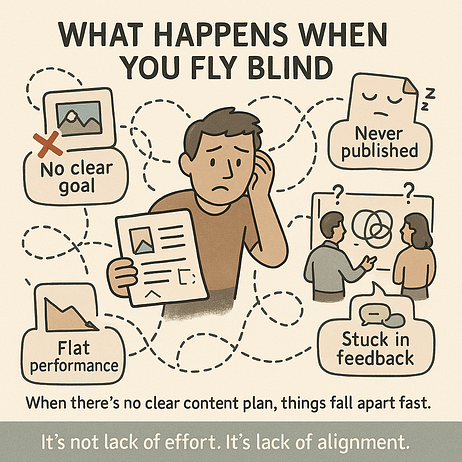
It’s not that you’re bad at content. You’re just flying blind.
Without a blueprint, you can’t align, scale, or improve. And over time, the cracks get harder to ignore.
The Hidden Cost of Not Having a Blueprint
It’s easy to brush off the lack of a strategy as a workflow issue. But the real cost? It’s deeper and compounding.
- Leads fall through the cracks because there’s no mapped journey to guide them.
- Team members burn out or misfire because expectations and priorities aren’t clear.
- There’s no repeatable process which means every quarter feels like starting from scratch.
- You miss out on visibility and sales because there’s no system for surfacing your best content.
- Internal buy-in fades because no one can point to consistent wins.
It’s not just inefficiency. It’s momentum lost. And over time, that turns into a brand that looks busy… but stays invisible.
Section I: What Is a Content Marketing Blueprint, and Why Is It Essential?
A content marketing blueprint is more than just a content calendar. So put Notion, Asana and every other tool away for now, okay?
What we’re talking about here is a living, strategic roadmap. One that connects every piece of content you create to the business outcomes you care about.
At its core, a content marketing blueprint does two things:
- Internally, it aligns your team, your workflows, and your goals. It keeps everyone – from writer to designer to stakeholder – moving in the same direction.
- Externally, it ensures your content meets your audience at the right time, in the right format, with the right message so it actually converts.
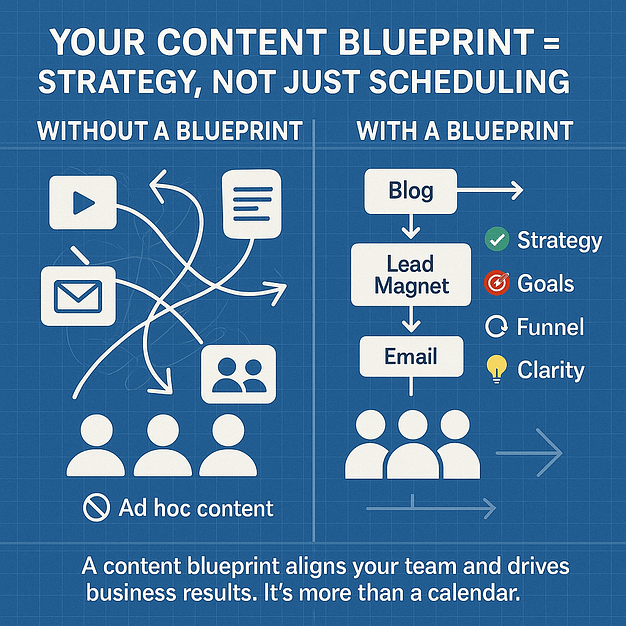
When done well, a blueprint becomes a content-powered sales engine. Seriously, no exaggeration here.
It turns your blog, email list, lead magnets, and video content into a unified system that attracts, nurtures, and converts your ideal customers without starting from scratch every time.
This is how you scale content sustainably, without burning out or losing clarity. And in a market where attention is tight and trust is low, that kind of alignment is what separates visible, high-growth brands from the rest.
Prefer to learn by watching?
Before we dive into the full breakdown, here’s a quick video walk-through of what a content marketing blueprint really is — and how it transforms scattered content into a strategic growth engine.
Watch it now, then keep scrolling for the deeper dive (with examples, tools, and templates).
Section II: How Do I Develop a Content Marketing Blueprint Step by Step?
You don’t need a 40-page strategy doc to build a blueprint. Seriously.
All you need is a clear, repeatable process that’s built to scale, even if you’re starting solo.
This is the structure I use whenever I build or reset a content system. Four phases. No fluff.
Phase 1: Foundation
This is where you define the “why” behind your content.
- Set clear business goals (e.g., leads, sales, retention)
- Clarify your brand’s voice and positioning
- Build audience personas with real data (learn more about personas here)
- Audit your existing content – what’s working, what’s dead weight?
Without this phase, everything else becomes really hard to figure out.
Phase 2: Planning
Now that you know where you're going, it’s time to map the route.
- Choose content types based on your funnel strategy (blogs, videos, emails, etc.)
- Build out pillar topics and supporting content ideas
- Create structured briefs that keep your message consistent
- Set up your editorial calendar for your SEO silos (new word? Learn more about SEO silos here)
This is where structure replaces stress.
Phase 3: Execution
Ideas are cheap. Execution is where strategy turns into growth.
- Define workflows and approval stages
- Assign roles and deadlines (even if it's all you for now)
- Build your publishing routine – think SEO, formatting, internal links
- Set up your distribution plan from day one
It’s not about volume. It’s about consistency, clarity, and control.
Phase 4: Iteration
Once it’s live, you’re not done. You’re just getting started.
- Set monthly or quarterly review cycles
- Look at what’s driving traffic, leads, conversions
- Update or retire content that underperforms
- Build a feedback loop into your workflow
This is how your content engine stays healthy over time.
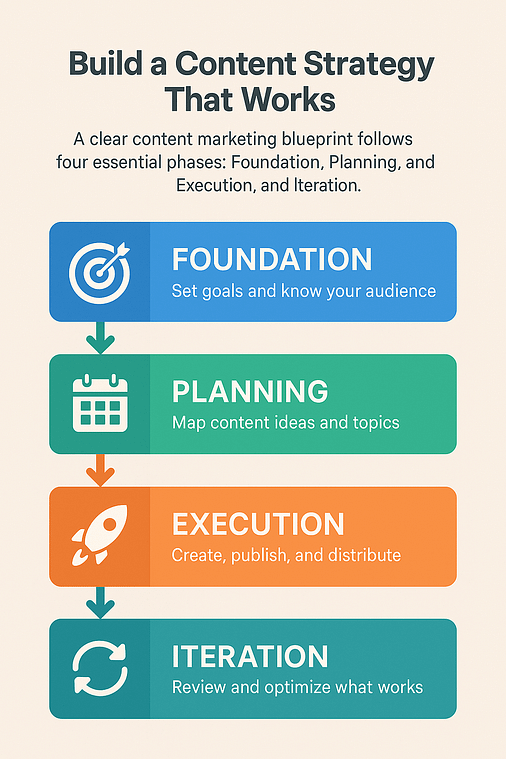
🧰 Pro Tip: How I Build My Blueprint (and Content) Visually
I keep it old school when I start planning – pen, paper, real thinking. That’s where my best ideas take shape. From there:
- I transfer everything into Notion – not because I use it every day, but because it’s a solid place to store notes, ideas, and research in one place.
- My content calendar lives in Asana. It’s great for tracking what’s in draft, what’s scheduled, what’s published. I like seeing that flow.
- I write all my blog posts in Google Docs – it’s simple, collaborative, and gets out of the way when I need to focus.
But publishing? That’s a different story. That’s where Thrive Suite comes in.
I use it to bring strategy into execution:
- Thrive Theme Builder handles the layout and structure of my site – fast, lightweight, and clean.
- Thrive Architect is where I design all my key pages — landing pages, blog layouts, lead magnet pages – with full control over how things look and convert.
- Thrive Quiz Builder is my secret weapon for next-level lead generation. I’ve used it to segment my list, personalize offers, and guide people through tailored journeys using quizzes.
Why am I telling you this? Because the tools you use aren’t just about creation. They shape your publishing rhythm, your visibility, and how efficiently you can execute the blueprint you’ve built.
Every step, from scribbles to final post, is part of the system. And when your system works, your content starts working too.
Section III: What Are the Key Components of an Effective Content Marketing Blueprint?
You wouldn’t build a house without walls, plumbing, or a roof, right?
Well, the same goes for your content strategy.
A real content marketing blueprint is a system where each part supports the others. If one’s missing, things collapse under pressure.
Here are the key structural components that hold everything together:
Brand Identity, Personas, Goals, and Value Proposition
This is your foundation. Your blueprint only works if it’s grounded in:
- A clear understanding of who you are (brand voice, tone, positioning)
- Who you’re speaking to (audience personas based on real data)
- What you're trying to achieve (specific, measurable business goals)
- And why anyone should care (your unique value proposition)
Without clarity here, every content decision becomes a coin toss.
Pillar Topics and Core Themes
Your content needs structure, not just variety.
Define a set of pillar topics that tie directly to your offer and your audience’s needs.
Then break those into supporting content themes that drive organic search, education, and trust.
This is how you build topical authority and stay relevant.
SEO Strategy + Distribution Channels
Content only works if people see it and if it reaches the right people.
- Map keywords and queries to your funnel stages
- Build internal linking strategies across your blog or resource hub
- Choose distribution channels based on audience behavior, not trends (email, search, social, YouTube, etc.)
You’re not just publishing. You’re placing content where it performs.
Workflows, Roles, and Templates
This is where most content plans break down: execution.
Even if it’s just you, document how things get done. Use:
- Brief templates
- Publishing checklists
- Approval steps
- Defined timelines or sprint cycles
When your system runs, your creativity doesn’t stall.
KPI Dashboards and Optimization Plans
Your blueprint isn’t complete until it includes how you’ll measure success and what happens after content goes live.
- Track funnel-specific metrics (traffic, leads, conversions, time on page) – I recommend using MonsterInsights for this. It’s the easiest way to understand Google Analytics.
- Create a regular review cadence (monthly, quarterly)
- Build in optimization routines (refreshes, rewrites, retirements)
This is how content becomes a growth asset, not just a deliverable.
Each of these components works together. Miss one, and it throws off the rest.
But when they’re all aligned? That’s when your content system becomes something you can grow predictably, repeatedly, and without burning out.
Section IV: How Do I Define and Research My Target Audience?
If you get this wrong, everything else falls apart.
You can build a beautiful content system, but if it’s speaking to the wrong people (or saying the wrong things) it won’t convert.
That’s why target audience research isn’t just the first step. It’s the engine of your entire content blueprint.
Your audience shapes everything: the tone you use, the platforms you show up on, the pain points you solve, and the action you ask for next.
Here’s how to make sure that foundation is accurate, useful, and built for real-world relevance:
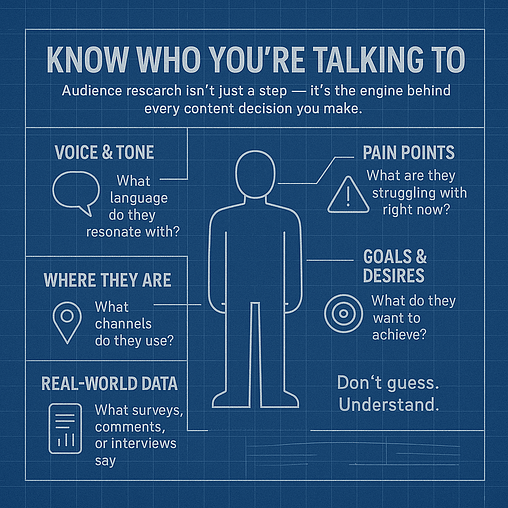
Start With Actual Data, Not Assumptions
You don’t need a research team, but you do need audience insights grounded in reality.
- Check Google Analytics (or MonsterInsights) and Search Console for demographics, user behavior, and high-performing content
- Review sales calls, surveys, DMs, or support queries – these are direct lines to what your audience is asking
- Interview 3–5 real customers or readers. Even short, casual conversations can reveal patterns and priorities you won’t find in spreadsheets
- Look at engagement metrics: what content are people staying on, sharing, or commenting on?
Build your personas from behavior, not bias. Your audience doesn’t always match your ideal, but they’ll always tell you who they are if you listen well.
Map the Buyer’s Journey
Every piece of content should meet people where they are and guide them one step forward.
That’s where buyer journey mapping comes in.
Ask:
- What does someone need to know before they consider a solution like yours? (awareness stage)
- What questions or concerns do they have when comparing options? (consideration stage)
- What motivates them to buy — and what keeps them loyal afterward? (decision + retention stage)
By aligning your content strategy to buyer intent, you stop guessing and start building real momentum with content that feels timely, helpful, and persuasive.
Pro Tip: If you’re new to the concept of “a buyer’s journey” and need extra guidance, check out this detailed guide.
Use Message Mining for Copy Clarity
- Sometimes, your audience will hand you your best messaging, you just have to know where to look.
- Scan testimonials, reviews, Reddit threads, Quora questions, or Facebook groups
- Highlight phrases that keep popping up: pain points, outcomes, specific objections
- Use that same language in your headlines, email subject lines, CTAs, and content intros
This is how you write content that sounds like it was written for your audience, not at them. It also sharpens your copy without relying on guesswork.
Adapt Tone and Format to Audience Maturity
A beginner and an expert don’t need the same kind of content. Neither do a time-strapped founder and a marketing assistant doing research between meetings.
Refine your approach by asking:
- Are they new to this problem, or already deep into comparing tools or solutions?
- Do they prefer step-by-step guides, short videos, visual explainers, or longform reads?
- Are they looking for education, validation, or action?
This level of content personalization isn’t about creating more. It’s about making what you already publish hit harder.
The closer your content feels to their reality, the more trust you build.
When you understand who you’re speaking to, what they need, and how they move through the buying process, everything else in your content strategy starts making sense.
Section V: What Content Types and Channels Should I Include?
It’s not enough to “do content.”
You need to create the right content, for the right stage of the funnel, and deliver it through the right channels.
This is where random publishing ends and a high-converting content strategy begins.
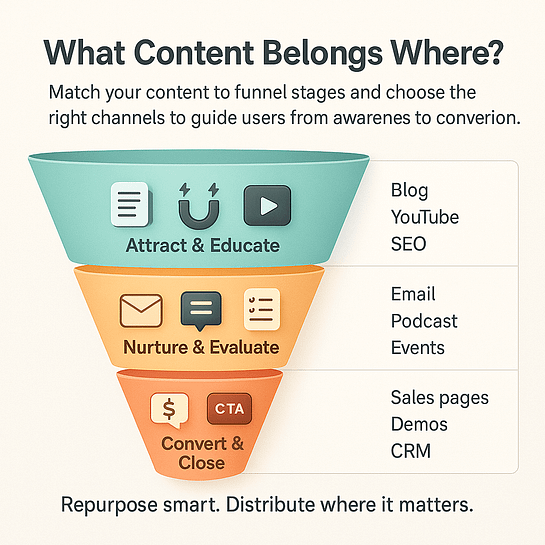
Match Content to Funnel Stages (TOFU → MOFU → BOFU)
Different content formats serve different purposes and they hit harder when they’re mapped to the content funnel. If you’ve ever felt like your content was solid but didn’t drive action, chances are it wasn’t matched to buyer intent.
Here’s the breakdown:
- Top of Funnel (TOFU):
Blog posts, YouTube videos, lead magnets, SEO-driven content – designed to attract and educate people who are just starting to explore the problem. - Middle of Funnel (MOFU):
Email sequences, case studies, webinars, product comparisons – built to nurture trust and help readers evaluate solutions. - Bottom of Funnel (BOFU):
Landing pages, product demos, pricing breakdowns, testimonials – anything that removes hesitation and moves people toward conversion.
Once you map content formats to your buyer journey, you stop publishing in the dark and start moving people with purpose.
Use a Balanced Mix: Evergreen, Promotional & Campaign Content
Not everything needs to rank forever, and not everything should expire overnight.
Your content blueprint should have a blend of:
- Evergreen content:
Pillar blog posts, FAQs, tutorials – built to drive consistent traffic and value over time. - Promotional content:
New feature announcements, limited-time offers, or event spotlights that support short bursts of attention and action. - Campaign content:
Multi-touch assets tied to product launches, seasonal pushes, or strategic partnerships.
This content mix helps you stay visible year-round, while still being nimble when it counts.
Choose Distribution Channels Based on Audience Behavior
You don’t need to be on every channel.
You just need to be on the right ones.
Use channel strategy that reflects how your audience actually consumes content:
- Use search-first platforms like blogs and YouTube for intent-driven discovery
- Use email for nurturing and high-converting communication
- Use social media for amplification, storytelling, and feedback loops
- Use your owned platforms (like your website, membership site, or Thrive Apprentice hub) for delivering long-form, trust-building content
Trends can be tempting but your best ROI will always come from meeting your audience where they already are.
Repurpose Content Across Formats to Maximize ROI
You don’t need to constantly create new content to grow.
You need to get more from what you already have.
This is where content repurposing becomes your best friend:
- Turn a high-performing blog post into a podcast episode
- Break a webinar into a nurture sequence or carousel posts
- Expand a FAQ section into dedicated SEO articles
- Convert internal docs into a public knowledge base or lead magnet
Every asset you repurpose is time saved and visibility gained without stretching your team or your budget.
When you align your content types with funnel stages, use the right distribution channels, and make repurposing a habit, your content blueprint becomes more than a plan.
It becomes a system that scales.
Section VI: How Do I Build a Content Marketing Workflow That Works, Even for Solo Creators?
You don’t need a team of five and a Slack full of notifications to run a proper content operation.
You just need a workflow that’s simple, consistent, and built to scale with you.
Here’s how to create one that doesn’t collapse the minute life gets busy.
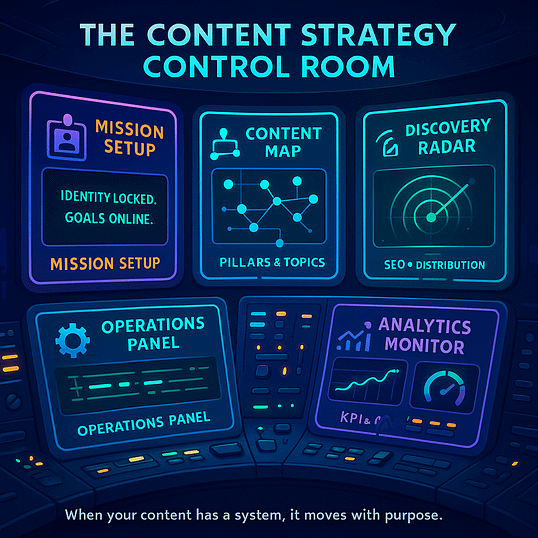
Create a Repeatable Content Production Process
Every piece of content should follow a clear path from idea → execution → publishing.
Whether it’s a blog post, a video, or an email, your steps should be:
Document this process. Make it your default — not something you re-invent every week.
Use Briefs, Templates, and Approval Checklists
- Reduce creative decision fatigue by standardizing your tools.
- Write your own content briefs (include target persona, CTA, key links, tone, etc.)
- Use headline swipe files and format templates to speed up writing
- Create a “ready to publish” checklist so you never miss a step
This makes your content sharper, faster to produce, and easier to delegate when the time comes.
Assign Roles — Even If It’s All You
Yes, it’s just you for now. But separating roles mentally helps.
Try structuring your week by hat:
- Monday: Strategist (plan topics, check metrics)
- Tuesday: Writer (draft content)
- Wednesday: Editor (review, revise, finalize)
- Thursday: Publisher (upload, format, distribute)
- Friday: Promoter (email, social, follow-up)
You’ll feel less scattered, and more like a media operation than a tired freelancer.
Track Everything With One Reliable System
Use whatever project management tool works for you — Notion, Asana, Google Sheets — but keep it simple.
You need:
- A master content calendar
- A status tracker (idea, draft, published, promoted)
- Deadlines with reminders
- Links to briefs, assets, and published content
If you’re using Thrive Apprentice, consider creating a private content operations hub where you organize and systemize all of this for easy access.
Plan for Feedback and Regular Reviews
Even if you’re solo, build a rhythm of reflection.
- Set aside 30 minutes at the end of each month to review what went live, what worked, and what didn’t
- Note what took too long, felt stressful, or flopped — then tweak your workflow
- Celebrate small wins. It keeps momentum going.
This turns content creation from a chore into a creative system that builds real equity over time.
Section VII: What Tools, Templates, and Frameworks Should I Use?
Content strategy gets overwhelming fast — not because it’s hard, but because everything feels important all at once. And if you don’t have a system that works with how your brain works, it’s easy to stall.
Here’s what I actually use (and recommend) to keep everything running smoothly — from planning to publishing to performance tracking:
Section VIII: How Do I Get Stakeholder Buy-In and Team Alignment for My Content Marketing Plan?
You can have the most brilliant content blueprint ever, but if no one understands it, trusts it, or actually uses it? It won’t go anywhere. Getting buy-in isn’t about forcing strategy down people’s throats. It’s about helping them see what’s in it for them and how it all fits together.
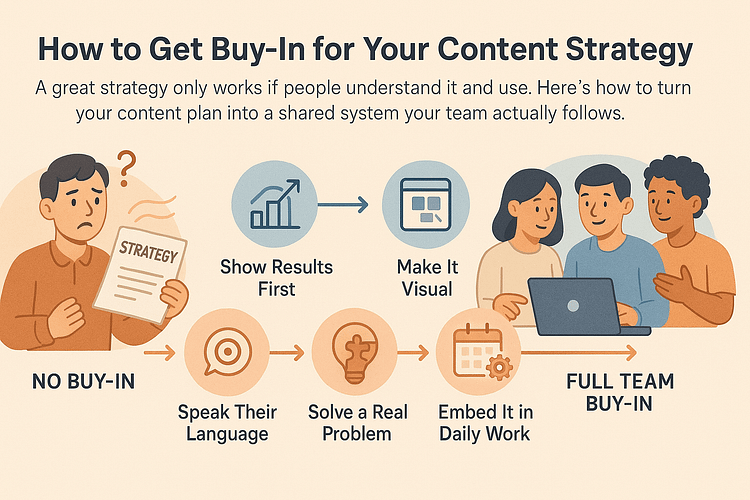
Here’s how I approach it:
FAQ: Real-World Questions About Building a Content Marketing Blueprint
These are the kinds of questions creators, business owners, and marketers ask when they’re *actually* trying to make a strategy work — not just theory, but real-world challenges.
Start simple: Google Docs for writing, Sheets for planning, and Notion or Trello for task management.
If you’re using Thrive Suite, build your visual blueprint with Thrive Architect and house your SOPs in Thrive Apprentice. That way, your system lives inside your website — not a dozen scattered tabs.
Break it into manageable phases (like we covered in Section II).
Start solo by defining goals, audience, and formats. Then build out your publishing and promotion workflows using templates and checklists. It’s 100% doable — especially with tools that reduce friction and automate repeat steps.
Nope — a calendar is just one piece of the blueprint.
A full blueprint includes your strategy, goals, personas, formats, workflows, and KPIs. The calendar shows when things go live. The blueprint shows why you’re creating them in the first place.
Always start with goals first. Is it leads? Brand authority? Revenue?
Then build your funnel and content around that — with SMART goals for each campaign or stage. Section VIII has a full breakdown of how to connect content to KPIs that matter.
Yes — just don’t let it run the whole show.
Use AI tools for outlining, brainstorming, or repurposing content, but layer in your own voice and brand strategy. You can even use ChatGPT to help build your SOPs, content templates, or topic clusters — just fact-check and refine before publishing.
Use one main content hub — a shared folder or tool where you store briefs, outlines, and published links.
Tag everything by funnel stage, persona, and goal. Keep a separate doc or sheet for performance tracking.
You can expand later — but this keeps things clean and manageable from day one.
Conclusion: You Don’t Need More Content. You Need a Smarter System.
The problem isn’t that you’re not creating enough content.
It’s that most of it isn’t wired to do anything.
A content marketing blueprint changes that. It gives your work structure, focus, and repeatability — whether you’re a solo creator or leading a growing team.
Let’s recap what it unlocks:
- Strategic alignment between content and your actual business goals
- Clear workflows that eliminate guesswork and save time
- Measurable performance tied to leads, sales, and long-term ROI
- A documented system your team can follow — and improve over time
This isn’t just an efficiency hack. It’s your competitive edge.
And now, you don’t have to build it from scratch.


